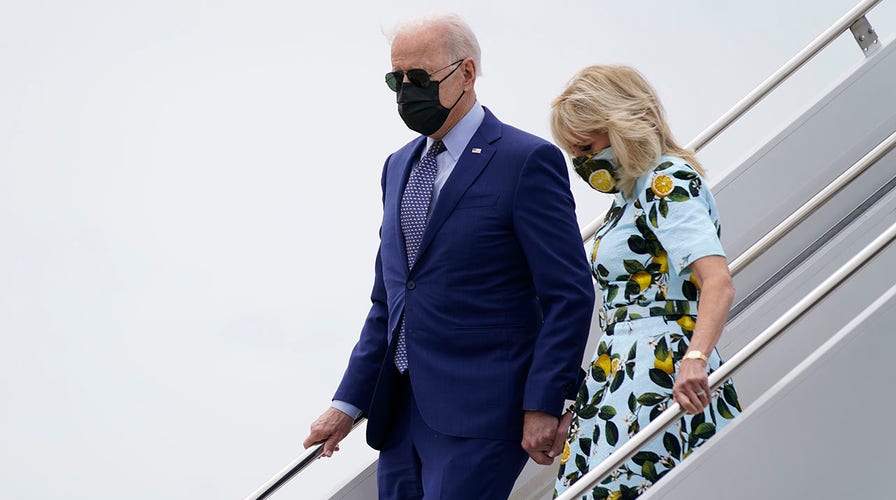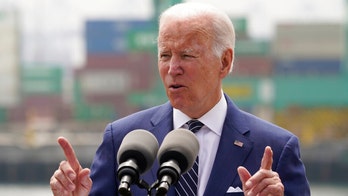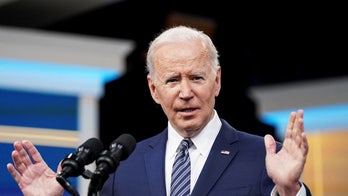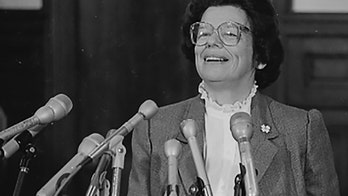Fox News Flash top headlines for April 30
Fox News Flash top headlines are here. Check out what's clicking on Foxnews.com.
President Biden headed Friday to Philadelphia to celebrate Amtrak’s 50-year anniversary and push for better funding of rail service that has a decades-long history of red ink.
As a former senator from Delaware, "Amtrak Joe" famously rode the train between his home in Wilmington and Washington, D.C., every day.
So it's perhaps not surprising that tucked into Biden’s American Jobs Plan is $80 billion earmarked for Amtrak, funding the railway he has said is necessary to rebuild the Northeast Corridor and address $45 billion in backlogged repairs.
Amtrak was founded in 1971 as a for-profit operation, but from that year through 2017, taxpayers footed an $81 billion bill, and the company has never turned a profit. Amtrak has traditionally relied upon annual appropriations to help pay for operations, including between $1.5 billion and nearly $2 billion in recent years. Part of the reason for the vast cost overruns is that more than one in four Amtrak trains -- and nearly half running long-distance routes -- are late.
"On-time performance (OTP)1 of Amtrak’s (the company) trains has been a longstanding challenge for the company, which identifies poor OTP as a key factor driving its annual operating loss -- about $171 million in fiscal year (FY) 2018," according to an October 2019 report by Amtrak's inspector general. "In that year, 27 percent of the company’s trains were late, with some routes performing better than others."
"The company’s best performing routes were its state-supported and Northeast Corridor (NEC) lines, which arrived on time 81 percent and 78 percent of the time, respectively. Long-distance routes, however, typically performed the worst; just 46 percent of trains arrived on time, and the average delay was 49 minutes."
Poor on-time performance "weakens the company’s financial position by reducing revenues and increasing operating costs," the report states.
BIDEN CELEBRATES AMTRAK'S 50TH ANNIVERSARY WITH PLANS TO EXPAND
Amtrak’s founders had not expected it to be a subsidized operation, according to Randal O’Toole, an American policy analyst with the Cato Institute.
"When it was created, they didn’t think it was going to lose money," O’Toole told Fox News of Amtrak’s founders. "They created it not as a government agency but as a corporation with stockholders. They thought it was going to make money."
Amtrak’s founders "testified in Congress they did not want to see congress subsidizing operating funds because it would just encourage wasteful spending on the part of the railroad being subsidized," O’Toole said.
Anthony Haswell, considered the "father" of Amtrak, said in the 1990s: "I feel personally embarrassed over what I helped to create."
Though Amtrak was designed as a for-profit entity, over the years lawmakers loosened that requirement, directing the agency to operate with the goal of turning a profit but making clear it would not be penalized if it did not.
O’Toole said that Amtrak has turned into a "political animal" to maintain the favor of Congress.
"Amtrak figured out really fast if they had trains into every important state and political congressional district, then lots of senators and congressmen would vote to fund it," he told Fox News. "Amtrak reaches 46 states. When a particular senator gets powerful, sometimes you’ll see new trains going into that state. Montana had a powerful senate delegation in the 1970s amtrak doubled train service to Montana."
"Amtrak is a very political animal," O’Toole continued. "Its goal is more to get dollars out of Congress than it is to carry passengers."
And even with a record 32.5 million riders in 2019, Amtrak posted an adjusted operating loss of $29.8 million, which was substantially less than fiscal year 2018’s $170.6 million. Amtrak believed it was on track to turn a profit for the first time ever in 2020, but that was before the COVID-19 pandemic.
Still, it often costs more to travel by train from New York to Boston or Washington, D.C., than by plane. O'Toole said that when subsidies are accounted for: "Amtrak is spending four times per passenger mile as airlines."
Because many of Amtrak’s lines don’t make any money or operate at a loss, and to accommodate money-losing routes, Amtrak charges more on its most popular Northeast Corridor routes.
But rail advocates, led by the president, say that propping up Amtrak is necessary both to connect rural and urban communities and to achieve ambitious climate goals.
BIPARTISAN STRATEGY IN WORKS TO CUT INFRASTRUCTURE BILL IN HALF
"For years I fought efforts to cut funding for Amtrak because cutting funding for Amtrak would be a disaster for our environment and our economy," Biden said at a ceremony celebrating Amtrak’s 50th birthday Friday at 30th Street Station in Philadelphia. "When I think about fighting climate change, I think about jobs, and rail, and hopefully the expansion of rail that provides good union jobs, good-paying jobs, but also connects people to jobs and economic opportunities that can be reached from wherever you live."
Sean Jeans-Gail, vice president of Government Affairs for the Rail Passengers Association, pointed out that the U.S. also subsidizes highways with hundreds of billions of dollars, and argued trains are a far safer way to travel.
"Congress has spent $158 billion in general taxpayer revenue to prop up the highway trust fund since 2008. The Congressional Budget Office projects a $134 billion for highways by 2030 -- which, since the gas tax hasn’t been raised since 1993, is likely to be funded through deficit spending," Jeans-Gail told Fox News.
CLICK HERE TO GET THE FOX NEWS APP
"Passenger rail is worthy of federal investment because it provides a safe and energy-efficient alternative to overcrowded highways," Jean-Gail said. "Over 38,800 Americans lost their lives to car crashes in 2019. I lost two members of my family to a car crash; I often wonder what would have happened if they had the option to get on a train that day."





